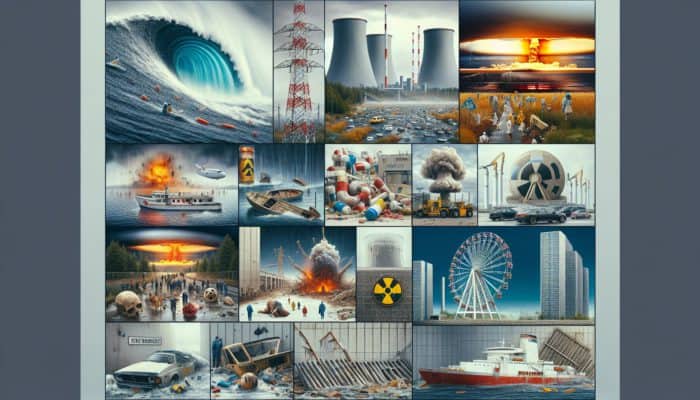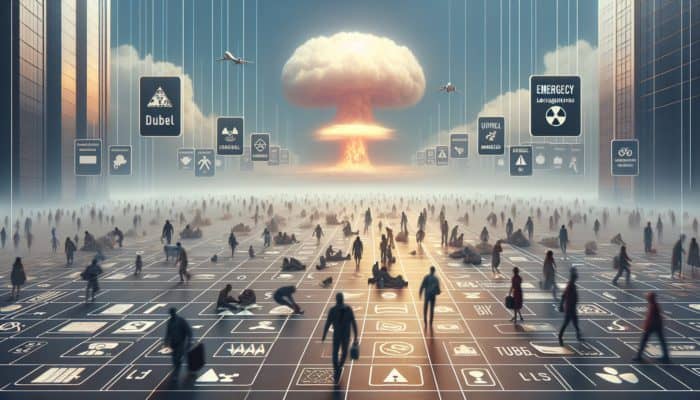Comprehensive Risk Assessment of Nuclear Incidents and Their Far-Reaching Effects
In-Depth Analysis of Various Types of Nuclear Incidents

Preparing for Nuclear Events is essential, as these incidents can arise from various origins, including accidents, intentional attacks, or natural disasters that compromise nuclear facilities. Each category presents unique challenges that require specific and tailored preparedness strategies. Accidental incidents, like reactor meltdowns or radioactive leaks, often stem from human errors or technological failures. A significant case is the devastating Fukushima disaster in Japan, where an immense tsunami disabled reactor cooling systems, which culminated in severe operational failures. Conversely, intentional attacks, particularly those targeting nuclear materials, pose substantial global risks, especially in politically volatile areas. Furthermore, natural disasters can critically undermine nuclear power plants, emphasizing the need for resilient infrastructures that can endure seismic activities and floods. The Chernobyl disaster serves as a poignant reminder of how inadequate design and governance can exacerbate crises.
Recognizing these differences is vital for developing effective preparedness strategies. Each incident type necessitates a customized response, underscoring the significance of a robust preparedness plan that aims to save lives and minimize risks. It is crucial to ensure that communities are well-informed and equipped to tackle various nuclear scenarios, thereby enhancing overall safety and resilience against potential disasters.
Analyzing the Probability and Consequences of Nuclear Events
Assessing the likelihood and potential consequences of nuclear events is integral to effective planning and resource distribution. This evaluation process involves a thorough examination of historical data and contemporary trends to identify vulnerable regions and plausible scenarios. For example, areas with aging nuclear facilities, particularly in Eastern Europe, face increased risks due to obsolete technology and infrastructure. By utilizing predictive modeling, authorities can simulate possible incidents and their repercussions, which aids in devising effective response strategies customized to specific threats.
Moreover, understanding the likely consequences—such as radiation exposure and community displacement—is essential for prioritizing resources and training initiatives. By meticulously evaluating these probabilities, stakeholders can create tailored response plans that significantly enhance community resilience against potential nuclear incidents. This proactive approach not only improves safety but also fosters confidence among residents regarding their preparedness for emergencies, instilling a sense of security within the community.
Identifying Key Factors that Elevate Risks Associated with Nuclear Events
Several factors contribute to the increasing risks associated with nuclear events. A major concern is the ageing infrastructure, particularly in facilities built several decades ago that may not adhere to modern safety standards. Additionally, political instability in a region can escalate these risks, especially when nuclear materials are involved. In countries with fragile governance frameworks, the threat of theft or misuse of nuclear resources significantly intensifies. Furthermore, technological failures, such as software glitches or equipment malfunctions, can lead to devastating incidents if not addressed promptly and effectively.
Recognizing these risk factors is essential for formulating effective mitigation strategies. Implementing regular inspections, upgrading technology, and establishing robust regulatory frameworks are necessary actions that can be adopted globally to lessen vulnerabilities in nuclear facilities, thereby enhancing safety and preparedness. By taking a proactive stance, communities can greatly reduce their exposure to nuclear risks, creating a safer environment for all residents.
Strategies for Comprehensive Risk Mitigation of Nuclear Events

Effectively executing strategies to mitigate risks associated with nuclear events is crucial for the protection of communities. Key strategies include adhering to strict safety protocols, which involve regular inspections and maintenance of nuclear facilities to ensure emerging issues are addressed promptly. International cooperation is also vital for enhancing nuclear safety, as sharing best practices and technological advancements can significantly strengthen preparedness and response capabilities. Nations can collaborate on emergency response drills, ensuring that all stakeholders are adequately prepared for potential nuclear incidents.
Moreover, cultivating a safety-centric culture within organizations managing nuclear facilities promotes vigilance and accountability. Training personnel to effectively identify and respond to potential threats can substantially decrease the likelihood of incidents occurring. By adopting a multifaceted approach that combines rigorous safety measures, international collaboration, and a strong safety culture, the risks associated with nuclear events can be significantly reduced, ensuring the safety of communities worldwide.
Insights from Experts on Nuclear Event Preparedness
Showcasing Successful Real-World Preparedness Initiatives
Real-world examples of effective nuclear event preparedness highlight the critical need for readiness and demonstrate successful strategies for risk mitigation. A notable instance is the U.S. Nuclear Regulatory Commission, which regularly carries out drills in partnership with local emergency services to ensure readiness for potential nuclear accidents. These comprehensive exercises simulate various scenarios, allowing participants to practice their response protocols and refine their actions based on invaluable lessons derived from these experiences.
Another significant example is the International Atomic Energy Agency (IAEA), which aids countries in creating robust emergency response frameworks. This encompasses training programs that emphasize the importance of community involvement in preparedness efforts. Such proactive measures serve as crucial case studies, illustrating the necessity of preparedness in mitigating the impacts of nuclear incidents on affected populations, ultimately fostering a culture of safety and readiness.
Actionable Steps for Immediate Responses After Nuclear Events

In the immediate aftermath of a nuclear event, swift and decisive actions are crucial for minimizing harm and ensuring safety. Individuals and communities should prioritize evacuation to a safe distance from the affected area. Familiarity with local evacuation routes and having a pre-established plan can significantly mitigate confusion and promote a rapid response. Furthermore, communities must identify specific shelter-in-place zones where residents can seek refuge if immediate evacuation is not feasible.
Implementing a comprehensive communication strategy is vital to ensure that accurate and timely information flows throughout the community. This may involve establishing emergency alert systems and utilizing local media to provide regular updates regarding the evolving situation. Lastly, individuals should have access to emergency kits containing essential supplies, which should be routinely checked and updated to ensure preparedness. These immediate response measures are critical for safeguarding lives and enhancing community resilience during nuclear emergencies.
Enhancing Preparedness Plans Through Expert Involvement
Experts play a vital role in improving the effectiveness and reliability of preparedness plans for nuclear events. Their engagement is essential in crafting comprehensive strategies that address potential risks while delineating clear response protocols. By conducting training sessions, experts empower communities with the necessary knowledge and skills to react adeptly during a nuclear incident. For instance, workshops focused on radiation safety and emergency response can instill confidence in individuals facing nuclear threats.
Additionally, experts can provide ongoing support and updates to ensure that preparedness plans remain relevant and effective in light of emerging technologies and evolving risks. Their insights can refine existing plans based on lessons learned from past incidents, ensuring continuous improvement in community preparedness. Collaborating with experts encourages a proactive approach to nuclear event readiness, thereby enhancing overall safety and resilience within the community.
Crafting a Robust Nuclear Event Preparedness Plan
Key Elements of a Comprehensive Nuclear Preparedness Plan
An effective preparedness plan for nuclear events must include several vital components to ensure a structured and efficient response. Emergency contacts, including local authorities and emergency services, should be easily accessible for rapid response during crises. Well-defined evacuation routes are also crucial, empowering residents to navigate to safety without hesitation during emergencies. Incorporating a supply list within the plan guarantees that individuals and families are equipped with essential items, such as food, water, and medical supplies.
Regular reviews and practice of the preparedness plan are essential for maintaining familiarity and efficiency during actual events. Each element of the plan should be tailored to the specific needs and resources of the community, taking into account factors such as population density and local infrastructure. By addressing these critical components, communities can significantly enhance their preparedness for nuclear incidents, ultimately saving lives and reducing panic during emergencies.
Collaborative Efforts for Effective Community Preparedness Plans
Collaboration among community members is vital for developing effective nuclear event preparedness plans. Organizing regular meetings allows stakeholders to share insights, resources, and experiences, fostering a sense of collective responsibility. Such gatherings can include representatives from local government, emergency services, educational institutions, and neighborhood organizations, ensuring that diverse perspectives are incorporated into the planning process.
Conducting joint drills enhances collaboration by enabling various stakeholders to practice their roles in a coordinated manner. These drills can simulate nuclear incidents, providing valuable hands-on experience that highlights areas for improvement. Moreover, communities can also share resources, such as emergency supplies and training materials, to ensure that all members are adequately equipped to respond to emergencies. This collaborative approach not only strengthens community bonds but also amplifies overall preparedness for potential nuclear events, creating a united front in the face of adversity.
Benefits of Regularly Updating Preparedness Plans
Regular updates to nuclear event preparedness plans are crucial for maintaining their relevance and effectiveness. As technology evolves and risks change, these plans must be adjusted to incorporate new methodologies and insights. For instance, advancements in radiation detection technology can enhance monitoring capabilities, necessitating updates to response protocols to ensure they remain effective.
Furthermore, lessons learned from prior nuclear incidents should inform revisions to the plan. By analyzing the effectiveness of responses in past events, communities can identify weaknesses and implement corrective measures. Regular updates also foster a culture of preparedness, encouraging individuals and organizations to stay engaged and informed about nuclear risks. Through consistent reviews and revisions, preparedness plans can be continually refined, ensuring they remain robust and reliable in the face of evolving challenges.
Training and Education Essentials for Nuclear Event Preparedness
Critical Training Programs for Effective Response
Implementing critical training programs is essential for equipping individuals with the necessary skills to respond effectively during nuclear events. Training should encompass first aid, focusing on triaging potential radiation exposure and addressing injuries that may arise during an incident. Additionally, radiation safety training is vital, empowering participants to understand the risks associated with nuclear exposure and the protective measures they can adopt to mitigate harm.
Emergency response protocols must also be a core element of training programs. Participants should engage in simulations and drills that replicate potential nuclear scenarios, enabling them to practice their responses in a controlled environment. Such training initiatives enhance individual confidence and preparedness, ultimately leading to more effective community responses during actual nuclear incidents. By investing in comprehensive training, communities can bolster their overall resilience against nuclear threats.
Offering Accessible Educational Resources for Public Knowledge
Providing educational resources to the public is fundamental to fostering widespread awareness and preparedness for nuclear events. Resources such as brochures, online courses, and community workshops can help disseminate crucial information regarding nuclear risks and preparedness measures. These educational initiatives should cover topics such as emergency kits, evacuation plans, and communication strategies, empowering individuals to take proactive steps to protect themselves and their families.
Furthermore, utilizing social media platforms can enhance outreach efforts by allowing organizations to share timely updates and educational content. Engaging the community through interactive programs and discussions can further reinforce the importance of preparedness. By prioritizing public education, communities can cultivate a culture of readiness that ensures individuals are well-informed and capable of responding effectively in the event of a nuclear emergency.
Implementing Effective Training in Schools and Workplaces for Nuclear Preparedness
Schools and workplaces play a critical role in implementing training programs that enhance preparedness for nuclear events. In educational settings, integrating preparedness training into existing safety protocols ensures that students and staff are familiar with response strategies. Regular drills can help students practice evacuation routes and become acquainted with emergency procedures, reinforcing their readiness during actual incidents.
Workplaces should similarly develop training programs that prioritize employee safety in the event of a nuclear event. Providing educational materials, conducting workshops, and hosting guest speakers can enhance overall awareness and preparedness. Collaborating with local emergency services for training sessions can further strengthen workplace readiness. By embedding preparedness training into institutional frameworks, schools and workplaces can significantly contribute to community resilience against nuclear risks, ensuring that everyone is prepared to respond effectively.
Critical Emergency Supplies and Equipment for Nuclear Events
Essential Supplies for Nuclear Event Preparedness
Having a well-stocked emergency kit is critical during nuclear events, as it significantly impacts survival rates. Essential supplies should include:
- Water: At least one gallon per person per day for a minimum of three days, providing hydration and sustenance.
- Non-perishable food: A three-day supply of items that do not require cooking or refrigeration, ensuring nourishment during emergencies.
- Radiation detectors: Devices like Geiger counters to monitor radiation levels and ensure safety.
- Protective gear: Items such as masks and radiation suits to minimize exposure to harmful substances.
- First aid kit: Basic medical supplies for treating injuries and health concerns.
- Flashlights and batteries: To ensure visibility during power outages and emergencies.
- Whistle: For signaling for help if trapped or in need of assistance.
- Local maps: To navigate to safety in the event of evacuation, guiding individuals away from danger.
Ensuring these supplies are readily available can significantly enhance individual and community preparedness, guaranteeing that essential needs are met during a crisis.
Maintaining and Storing Emergency Equipment Properly
Proper maintenance and storage of emergency equipment are vital to ensuring its functionality during a nuclear crisis. Equipment such as radiation suits and Geiger counters should be regularly inspected for signs of wear and tear, ensuring they remain effective when needed. Establishing a routine maintenance schedule can help identify any issues before they escalate into critical problems, thus preserving the integrity of essential supplies.
Moreover, storage conditions play a significant role in equipment readiness. Items should be kept in a cool, dry place, away from direct sunlight, to prevent deterioration and extend their lifespan. Clearly labeling storage containers and maintaining an inventory of supplies can streamline access during emergencies, ensuring that community members can quickly locate the necessary equipment. By prioritizing maintenance and proper storage, individuals and communities can enhance their preparedness for nuclear events, ultimately saving lives.
Steps for Individuals to Assemble Personal Emergency Kits for Nuclear Events
Individuals can take proactive measures to prepare their own emergency kits by gathering necessary supplies tailored to their specific needs. Start by including essential items such as food, water, and medical supplies, ensuring to account for the number of people in the household. Regularly checking expiration dates and replacing items as needed is crucial to maintaining the kit’s effectiveness and readiness for any potential emergency.
Storing kits in easily accessible locations ensures that they can be quickly retrieved during emergencies. Consider designating a specific area in the home for the emergency kit, where all family members are aware of its location. Additionally, encouraging family discussions about the contents of the kit and the importance of preparedness can foster a collective sense of readiness. Personal emergency kits are indispensable for individual preparedness, empowering families to respond effectively during nuclear incidents and ensuring safety.
Effective Communication Strategies During Nuclear Events
Establishing Trustworthy Communication Channels
Establishing reliable communication channels is crucial for disseminating information during nuclear events. Implementing emergency alert systems ensures that critical updates are delivered directly to residents, providing timely information regarding evacuation orders or safety protocols. Additionally, utilizing radio broadcasts can reach a broader audience, particularly in areas with limited internet access, ensuring that all community members are informed.
Communities should prioritize developing robust communication networks that involve local authorities, emergency services, and community organizations. This collaboration guarantees that accurate information is shared promptly, thereby minimizing the risk of misinformation during crises. By establishing dependable communication channels, communities can enhance their overall response efforts to nuclear events, ensuring that everyone remains informed during emergencies.
Best Practices for Effective Communication During Nuclear Events
Effective communication during nuclear events relies on several best practices. Clear and concise messaging is paramount, ensuring that crucial information is easily understood by all community members. Regular updates should be provided to keep the public informed about the evolving situation, especially as new developments arise.
Utilizing multiple communication methods can broaden the reach of messages. For instance, combining text alerts, social media updates, and traditional media can help ensure that information reaches a diverse audience. Establishing a community information center can also serve as a hub for inquiries and updates during a nuclear event, assisting in coordinating responses and alleviating public concerns. By implementing these best practices, communities can enhance their communication efforts during nuclear incidents, ensuring everyone stays informed and safe.
Leveraging Social Media Effectively During Emergencies
Social media can be an invaluable tool for improving communication during nuclear events. Utilizing platforms like Twitter and Facebook enables authorities to provide real-time updates, allowing for the swift and efficient dissemination of critical information. Engaging with the community via social media can also facilitate two-way communication, enabling residents to pose questions and receive immediate responses from officials or experts.
Proper use of social media involves maintaining a consistent tone and ensuring that shared information is accurate and verified before dissemination. Establishing a designated team to oversee social media communications can streamline efforts and mitigate the spread of misinformation, which can heighten panic during emergencies. By harnessing the capabilities of social media, communities can enhance their communication strategies and effectively coordinate responses during nuclear emergencies, ultimately improving public safety.
Proven Strategies for Preparing for Nuclear Events
Expert Analysis on Effective Evacuation Plans
Expert analysis on evacuation plans is essential for ensuring their robustness and effectiveness during nuclear events. Evacuation plans should clearly define routes that account for the fastest and safest paths away from affected areas while considering potential obstacles. Experts can provide insights on optimal timing for evacuations, as traffic congestion can significantly hinder response efforts and delay safety.
Coordination with emergency services is equally vital, as authorities can provide real-time information about hazards and road conditions that might influence evacuation routes. Regularly reviewing and updating evacuation plans based on expert recommendations ensures that communities remain prepared and responsive to potential nuclear incidents. By involving experts, communities can enhance their evacuation strategies, ultimately safeguarding lives during emergencies and ensuring a more effective response.
Implementing Effective Shelter-in-Place Protocols
Implementing shelter-in-place protocols is crucial for immediate safety during nuclear events. These protocols involve remaining indoors, sealing rooms, and employing protective measures to minimize radiation exposure. Communities should establish clear guidelines on how to effectively shelter in place, including identifying safe zones within buildings and ensuring access to necessary supplies to sustain residents during the crisis.
Residents should be educated on the importance of sealing windows and doors to prevent contaminated air from entering their homes. Utilizing air filtration systems or improvised methods, such as damp towels, can further enhance protection against radioactive particles. By implementing and practicing shelter-in-place protocols, communities can significantly reduce exposure risks during nuclear incidents, thereby enhancing overall safety and preparedness for residents.
Effective Decontamination Methods Following Nuclear Events
Effective decontamination methods are essential for ensuring safety after nuclear events. The primary techniques include using soap and water to wash radioactive particles off exposed skin and clothing, a straightforward yet highly effective approach that can significantly decrease contamination levels. Community training on these methods is vital to ensure everyone understands how to protect themselves effectively.
Specialized cleaning agents may also be utilized for surfaces and equipment to guarantee thorough decontamination. Following expert guidelines is critical, as they can offer specific recommendations tailored to the incident and contamination levels. Community training on decontamination practices can further enhance individual preparedness, ensuring residents are equipped to manage potential contamination effectively. By implementing these methods, communities can improve safety during and after nuclear events, promoting recovery and resilience.
Raising Public Awareness on Nuclear Event Preparedness
Educating the public on nuclear event preparedness involves disseminating comprehensive information regarding safety measures, emergency kits, and communication strategies. Community workshops and informational sessions can serve as platforms for sharing knowledge and addressing public concerns about nuclear risks, fostering a well-informed populace.
Utilizing various channels, including social media, local newsletters, and community bulletins, can enhance outreach efforts and ensure that critical information reaches all demographics. Providing accessible materials that outline preparedness steps and resources can empower individuals to take proactive measures to safeguard themselves and their families. Engaging the public in discussions about nuclear safety cultivates a culture of resilience and readiness, ultimately enhancing overall community preparedness for nuclear incidents.
Psychological Preparedness for Nuclear Events
Effective Coping Mechanisms for Managing Stress and Anxiety
Coping mechanisms for managing stress and anxiety during nuclear events are essential for maintaining community resilience. Techniques such as mindfulness and deep breathing exercises can help individuals remain grounded in high-stress situations, promoting mental well-being and clarity. Furthermore, establishing support groups enables individuals to share their experiences and coping strategies, thereby fostering a sense of community and collective support during challenging times.
Professional counseling may also prove beneficial, providing individuals with access to trained therapists who can offer tools to navigate their emotional responses during crises. Communities can organize workshops focused on mental health awareness, helping residents recognize and address their psychological needs during nuclear events. By emphasizing mental health preparedness, individuals can enhance their ability to cope with the psychological impacts of nuclear incidents, ultimately fostering a more resilient community.
Community Support for Mental Health During Nuclear Events
Communities can play a pivotal role in supporting mental health during nuclear events by providing vital resources and establishing support networks. Organizing community events that promote mental health awareness can encourage open discussions about stress and anxiety related to nuclear risks, normalizing these important conversations.
Offering access to trained mental health professionals for counseling services can further strengthen community support systems. Establishing crisis hotlines can also provide immediate assistance for individuals in distress, ensuring they have a reliable avenue for help during emergencies. By actively promoting mental health resources, communities can enhance psychological resilience and assist individuals in navigating the challenges associated with nuclear events, fostering an environment of care and support.
The Role of Education in Enhancing Psychological Preparedness
Education is crucial in psychological preparedness for nuclear events as it informs individuals about the risks, available preparedness measures, and effective coping strategies. Providing educational materials focused on mental health can empower individuals to understand their emotions and responses during crises, enabling them to approach challenges with greater confidence.
Workshops and seminars can facilitate discussions about the psychological aspects of nuclear preparedness, equipping community members with tools to manage anxiety. Promoting educational initiatives in schools and workplaces can raise awareness about mental health issues and encourage proactive approaches to psychological preparedness. By fostering a culture of education surrounding mental health, communities can enhance overall resilience and preparedness during nuclear incidents, ensuring that individuals are equipped to handle the stresses associated with such events.
Preparing Families Psychologically for Nuclear Events
Families can prepare psychologically for nuclear events by engaging in open discussions about nuclear risks and collaboratively creating emergency plans. Crafting a comprehensive family plan that outlines actions to take during a nuclear incident can instill confidence in each family member’s ability to respond effectively, ensuring everyone understands their role.
Practicing coping strategies together, such as mindfulness techniques or deep breathing exercises, can strengthen collective resilience and promote emotional well-being within the family unit. Encouraging family members to express their feelings and concerns about nuclear risks fosters a supportive environment where everyone’s emotional needs are addressed. By prioritizing psychological preparedness within the family, individuals can enhance their readiness for potential nuclear events, fostering a sense of security and unity.
The Importance of Mental Health First Aid Training During Nuclear Crises
Mental health first aid training is essential for equipping individuals to provide initial support to those experiencing psychological distress during nuclear crises. This training teaches participants to recognize signs of mental health struggles and respond appropriately, offering reassurance and guidance to affected individuals, thereby creating a supportive community atmosphere.
By establishing community members as mental health first responders, communities can leverage their collective strengths to support those in need effectively. Providing resources and training on mental health first aid can enhance overall community resilience, ensuring that individuals have access to timely assistance during nuclear events. By prioritizing mental health support, communities can mitigate psychological distress and promote healing after crises, ultimately fostering a healthier society.
Long-Term Recovery and Rehabilitation Following Nuclear Events
Strategies for Sustainable Long-Term Recovery After Nuclear Incidents
Long-term recovery strategies following nuclear events are crucial for rebuilding communities and restoring normalcy. These strategies may encompass reconstructing infrastructure, reinstating essential services, and providing ongoing support to affected populations to help them regain stability. Establishing clear timelines and objectives for recovery can help communities maintain focus on achieving these goals.
Moreover, engaging community members in the recovery process fosters a sense of ownership and empowerment, ensuring that the voices of affected individuals are heard. Collaborative efforts involving local leaders, governmental agencies, and non-profit organizations can enhance the effectiveness of recovery initiatives, ensuring that resources are allocated where they are most needed. By prioritizing long-term recovery strategies, communities can rebuild resilience and provide adequate support for those impacted by nuclear events, promoting healing and revitalization.
Key Challenges in Rehabilitation Efforts
Significant challenges in rehabilitation after nuclear events include managing radiation contamination, addressing health concerns, and rebuilding community trust. Contaminated land and infrastructure present substantial obstacles, necessitating specialized cleanup efforts and ongoing monitoring to ensure safety for all residents.
Health concerns may arise due to potential radiation exposure, requiring comprehensive medical assessments and support for affected individuals to address their needs. Rebuilding community trust is similarly critical, as past incidents may engender skepticism regarding safety measures and governmental responses. Addressing these challenges through transparency, community engagement, and ongoing support is vital for successful rehabilitation after nuclear events, ensuring that affected populations feel secure and protected.
Building Resilience for Future Nuclear Events
Building resilience for future nuclear events involves learning from past experiences and implementing enhanced preparedness measures. Communities should prioritize the development of robust emergency response plans that reflect lessons learned from previous incidents, ensuring that strategies are effective and comprehensive.
Fostering a culture of readiness through continuous training, education, and community engagement ensures that residents remain informed about risks and preparedness strategies. By investing in infrastructure improvements and conducting regular drills, communities can bolster their overall resilience to nuclear events. Through collective efforts and a steadfast commitment to preparedness, communities can secure better outcomes during future nuclear incidents, ultimately safeguarding the well-being of their residents.
Addressing Common Inquiries About Nuclear Event Preparedness
What are the main categories of nuclear incidents?
Nuclear incidents can be classified as accidental, intentional (e.g., terrorism), or natural disasters impacting nuclear facilities. Each type requires distinct preparedness strategies tailored to the specific incident.
How can I assess the likelihood of a nuclear event occurring?
Evaluating the likelihood involves analyzing historical data, current trends, and factors such as aging infrastructure and political stability to identify potential risks and vulnerabilities within communities.
What factors heighten the risks related to nuclear events?
Factors such as aging infrastructure, political instability, and technological failures can increase the risks associated with nuclear events, necessitating proactive measures to mitigate these threats.
What strategies effectively mitigate nuclear risks?
Implementing safety protocols, conducting regular maintenance, and fostering international cooperation are effective strategies for reducing nuclear risks and enhancing overall safety.
Can you provide examples of successful preparedness initiatives?
Examples of successful preparedness include the routine drills conducted by the U.S. Nuclear Regulatory Commission and the support from the IAEA to enhance community readiness through training and resources.
What immediate actions should I undertake following a nuclear event?
Immediate actions include evacuating to a safe location, sheltering in place if necessary, and accessing reliable information through emergency communication channels to ensure safety.
How do experts contribute to developing preparedness plans?
Experts contribute by formulating comprehensive plans, conducting training sessions, and providing ongoing support to enhance community readiness and resilience before and after nuclear events.
What key components should be included in a preparedness plan?
Key components include emergency contacts, evacuation routes, and supply lists to ensure a structured and efficient response to nuclear events, safeguarding lives.
How can schools implement training for nuclear preparedness?
Schools can integrate preparedness training into existing safety protocols, conduct regular drills, and provide educational materials to students and staff to enhance overall preparedness.
Why is mental health support crucial during nuclear events?
Mental health support is vital for managing stress and anxiety, aiding individuals in coping with the psychological impacts of nuclear events, and fostering community resilience.
Discover more with us on X!
The post Preparing for Nuclear Events: Essential Strategies appeared first on Survival Bite.
The Article Nuclear Events: Key Strategies for Effective Preparation Was Found On https://limitsofstrategy.com
The Article Key Strategies for Effective Preparation in Nuclear Events First Appeared ON
: https://ad4sc.com










No responses yet